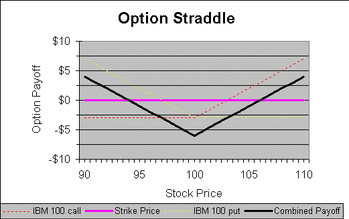What is a Combination Trade?
A combination trade is an option strategy where the trader takes a position in both call and put options in the same underlying stock. While there are multiple types of combination trades, in this section we will look at a very popular trade called a long straddle. In this particular type of trade, an investor will purchase both a call and put on the same stock, and both of these options will have identical strike prices and expiration dates.
How Does a Combination Trade Work?
For the sake of example, we will look at a very popular combination trade called a long straddle. Let’s take a look at an example of how a straddle trade works...
Let's assume that IBM is currently trading at $100 per share. Due to a significant event that will occur this month (an expected news event, earnings release, etc.), an investor might believe that the stock will move at least 10% in either direction. In this example, let's assume that both the IBM 100 put options and IBM 100 call options are trading at $3 each. To take advantage of this the investor would enter into a straddle trade by purchasing both the IBM 100 put for $3 and the IBM 100 call for $3 (for a total of $6 out of pocket).

As you can clearly see in the payoff diagram of this trade above, this particular straddle will be profitable if the price of the stock moves more than $6 in either direction by the time the options expire. If the price remains at exactly $100, then the investor will suffer a maximum loss of $6. Once the price of IBM's underlying shares moves beyond $94 or $106 the investor will begin to realize a profit from the trade. If the price does indeed move at least 10%, as the investor predicted, to either $90 or $110, then the profit will be $4 ($10 sale of option - $3 purchase of call - $3 purchase of put).
Why Does a Combination Trade Matter?
It may initially sound counterintuitive to be on both the long and short side of the same stock. After all, if you're only trading regular common stocks, it doesn't make sense to be both long and short at the same time. In the wonderful world of options, however, it is sometimes beneficial to enter into this type of trade. Straddles are designed to allow investors to profit from a large move in a given stock. The beautiful thing about them is that the actual direction the stock takes does not matter, the only thing that matters is whether the stock makes a substantial move. This is the key point to trading straddles. An investor does not have to be certain which direction the stock will move; just certain it will move strongly one way or the other. Because of this, straddles make an excellent choice in choppy markets where the only certainty is high volatility.



